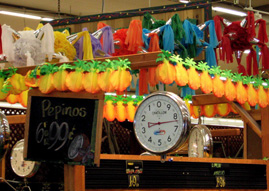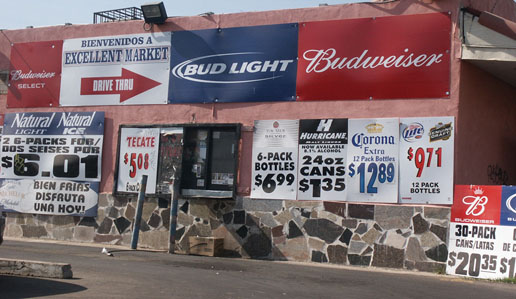|
|
||||
Impromptu InterviewAsh Rupp
After Dr. K set us free to explore South Phoenix for the first time
on our own, I realized just how little I knew about the area. South
Phoenix has always been a place I have driven through on my way to
another destination; it has never been the destination. I felt so
uninformed that I had been living in the valley for almost seven
years and I had never developed a familiarity with the area. As my
team and I drove around trying to get our bearings, I felt as if I
was in a different city or even country. Iím used to seeing signs
sprinkled with Spanish, but nearly everything was in Spanish here.
In the areas of town Iím more familiar with (Scottsdale and North
Phoenix) Spanish lettering is used to convey an exotic feeling to
rather mundane Anglo places. Not so here. If you didnít speak
Spanish, you were out of luck. After driving up and down Central Avenue, we decided to stop at a family owned convenience store east of Central and Broadway to begin generating more ideas about where we wanted to concentrate the remainder of our day. The convenience store we stopped at was like no store I had ever been in before. There were bars on all of the windows and signs and stickers advertising products in Spanish everywhere. We walked in and I noticed that we were the only people who didnít seem to know the owner well. The other customers were all gathered around the front counter chatting and smiling. I began to feel like we were intruding. We were also the only people not speaking Spanish. In broken Spanish Jackie asked the clerk if we could take pictures. He said yes and we started browsing around and taking pictures of products that we had never seen before (i.e. Mexican candy, sodas, and cleaning products). As I was trying to make my way down the narrow aisle way I stumbled on someoneís foot. I looked up and in the back corner of the store where I was exploring there was a policeman sitting on a crate, monitoring the store. I apologized for tripping on him and then explained why we were in here. I told him that we were form ASU West and we were taking an Urban Anthropology course that studied the changes occurring in South Phoenix. He looked really confused. I asked him if he had noticed the changes that the new construction had facilitated in the area. He answered by telling me that this was an unsafe area and he encouraged me to leave. I told him that our presence was for school and he then reiterated the danger of the neighborhood. I
repeated my first question, had he noticed any changes? He shrugged
and said that he hadnít noticed any changes. I couldnít hide my
shock. After everything I had read about the new construction in
South Phoenix I could not believe that someone who spent everyday
out here would not have noticed any changes. He said that crime was
still rampant, the gangs were still very active, and that while
there was new construction; it wasnít helping anything. From what
he had seen the new houses were being bought by people from out of
town who donít ďknow the area.Ē After they figured out what they had
ďgotten themselves intoĒ they would try to sell the homes. The
problem is, he continued, the current residents can not afford to
buy the new homes, and anyone who has seen the area doesnít want to
live there either. He said the gated communities were fairing a
little better, but you canít stay in your gated community forever,
you have to go to the store, and work, and school. He said that he
did not think that this new construction would last. He said you can
dress South Phoenix up any way you like, but it is still South
Phoenix. I thanked him and told him we would be careful (he was
still worried about us being in the area).
|
||||
|
|
||||


